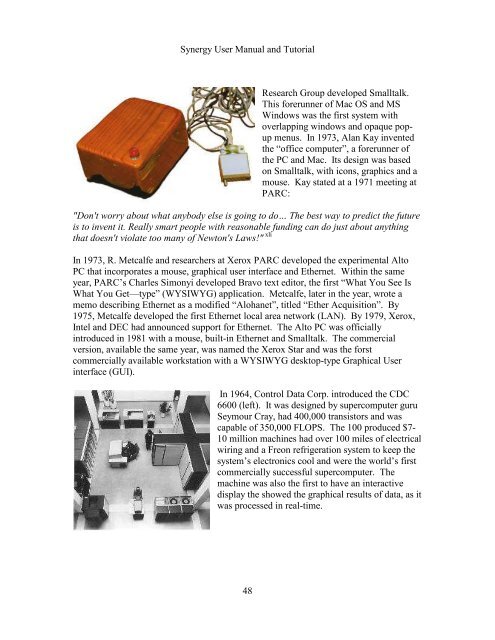Synergy User Manual and Tutorial. - THE CORE MEMORY
Synergy User Manual and Tutorial. - THE CORE MEMORY
Synergy User Manual and Tutorial. - THE CORE MEMORY
Create successful ePaper yourself
Turn your PDF publications into a flip-book with our unique Google optimized e-Paper software.
<strong>Synergy</strong> <strong>User</strong> <strong>Manual</strong> <strong>and</strong> <strong>Tutorial</strong><br />
Research Group developed Smalltalk.<br />
This forerunner of Mac OS <strong>and</strong> MS<br />
Windows was the first system with<br />
overlapping windows <strong>and</strong> opaque popup<br />
menus. In 1973, Alan Kay invented<br />
the “office computer”, a forerunner of<br />
the PC <strong>and</strong> Mac. Its design was based<br />
on Smalltalk, with icons, graphics <strong>and</strong> a<br />
mouse. Kay stated at a 1971 meeting at<br />
PARC:<br />
"Don't worry about what anybody else is going to do… The best way to predict the future<br />
is to invent it. Really smart people with reasonable funding can do just about anything<br />
that doesn't violate too many of Newton's Laws!" xli<br />
In 1973, R. Metcalfe <strong>and</strong> researchers at Xerox PARC developed the experimental Alto<br />
PC that incorporates a mouse, graphical user interface <strong>and</strong> Ethernet. Within the same<br />
year, PARC’s Charles Simonyi developed Bravo text editor, the first “What You See Is<br />
What You Get—type” (WYSIWYG) application. Metcalfe, later in the year, wrote a<br />
memo describing Ethernet as a modified “Alohanet”, titled “Ether Acquisition”. By<br />
1975, Metcalfe developed the first Ethernet local area network (LAN). By 1979, Xerox,<br />
Intel <strong>and</strong> DEC had announced support for Ethernet. The Alto PC was officially<br />
introduced in 1981 with a mouse, built-in Ethernet <strong>and</strong> Smalltalk. The commercial<br />
version, available the same year, was named the Xerox Star <strong>and</strong> was the forst<br />
commercially available workstation with a WYSIWYG desktop-type Graphical <strong>User</strong><br />
interface (GUI).<br />
In 1964, Control Data Corp. introduced the CDC<br />
6600 (left). It was designed by supercomputer guru<br />
Seymour Cray, had 400,000 transistors <strong>and</strong> was<br />
capable of 350,000 FLOPS. The 100 produced $7-<br />
10 million machines had over 100 miles of electrical<br />
wiring <strong>and</strong> a Freon refrigeration system to keep the<br />
system’s electronics cool <strong>and</strong> were the world’s first<br />
commercially successful supercomputer. The<br />
machine was also the first to have an interactive<br />
display the showed the graphical results of data, as it<br />
was processed in real-time.<br />
48

















